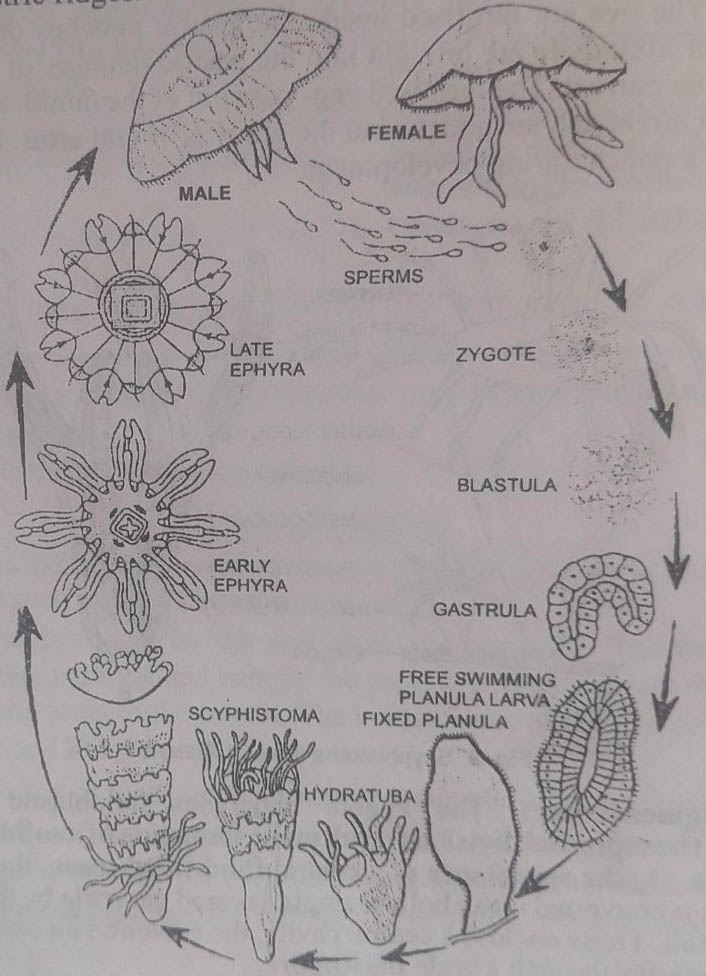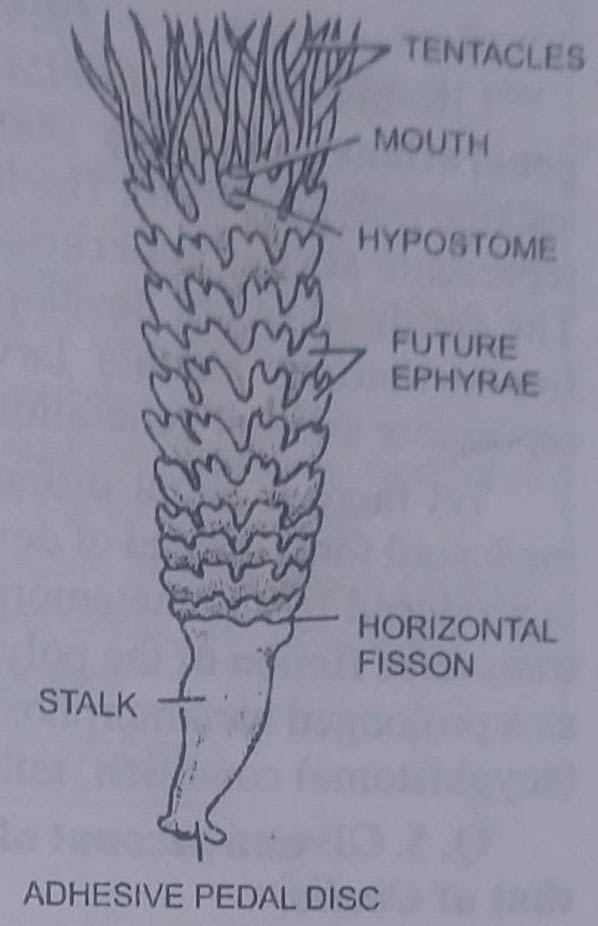Q. 3. Describe the life history of Aurelia
Or
Give an illustrated account of the life history of Aurelia. Does it exhibit an alternation of generations?
Ans.3.
1. Fertilization: The male and female gametes are formed on separate umbrellas. The ova are fertilized inside the gastric pouches of females. The spermatozoa from males are brought into the gastric pouches of females along with the water current.

The fertilised eggs pass out of the mouth along with the used water current and are attached to the grooves of oral arms. Each remains enclosed in a pouch during development.
3. Planula larva: Soon the blastopore of the gastrula closes. Its ectoderm develops cilia and the embryo elongates resulting in the formation of a planula larva. A large number of planulae may be found as minute opaque patches on the oral arms. These escape and start free existence.
4. Development of planula into scyphistoma: After a brief free-swimming existence, the planula loses its cilia, and attaches to some seaweed or stone. The basal part becomes narrowed into a stalk-like basal disc, the body elongates and the distal free end develops a mouth. Tentacles appear around the mouth. The two per-radial tentacles arise first and the other two at right angles to the previous ones develop later. Subsequently, four inter-radial and eight adradial tentacles are also formed. The planula metamorphoses into a trumpet-shaped, hydra-like polyp known as hydratuba or scyphistoma larva.
Simultaneously, the endoderm of the enteric cavity rises into four longitudinal ridges which occupy inter-radial position. These are known gastric ridges, septa or taenioles. The mouth is drawn into four angles and its edge becomes raised to form a short and inconspicuous manubrium. The ectoderm of the oral region becomes invaginated to form inter-radial funnel-shaped depressions, the septal funnel, or infundibula. These lie just above the gastric ridges.

The scyphistoma feeds and grows to a height of about 12 mm and sometimes multiplies asexually by budding. The lateral buds separate and lead to free existence like hydratuba.
5. Strobilation in scyphistoma: During autumn and winter the body of scyphistoma divides by a series of ring-like transverse constrictions.

These gradually deepen to give the appearance of a pile of saucers, placed one above the other. The process is known as strobilation, with each segment as ephyra and the body of the larva as strobila. About a dozen ephyrae are formed in a single strobilation. The basal segment of scyphistoma grows new tentacles and forms a hydratuba which again multiplies by budding in summer and undergoes strobilation during winter. The fully formed ephyrae detach, turn upside down and start free-swimming existence.
6. Ephyra: The ephyra represents a young medusoid form with a shallow saucer-shaped umbrella produced into eight bifid lobes or arms. Four of them are per-radial and the other four are radials.

The deeply notched distal ends of each lobe form marginal lappets. The notch carries a tentaculocyst or rhopalium. The ephyra possesses a small stomach with a short manubrium and a four-sided mouth on its subumbrella surface. The stomach is continued into the arms as per-radial and inter-radial canals. The gastric ridges are replaced by gastric filaments.
7. Metamorphosis of ephyra into Aurelia: The ephyra feeds and grows in size. Its mesogloea gets enormously developed. The adradial regions increase more rapidly to obliterate and fill the notches so that a nearly circular disc or umbrella is formed. Four oral arms and numerous marginal tentacles are also developed. The adradial canals also develop after some time. The four inter-radial septal funnels persist as subgenital pits.
BSc 1st Year Lower Non-chordates Aurelia Sample Model Practice Question Answer Papers